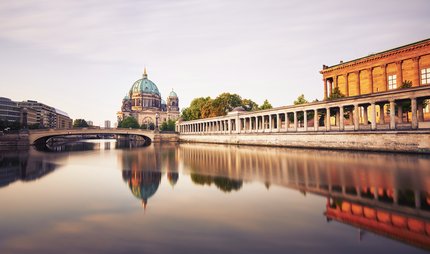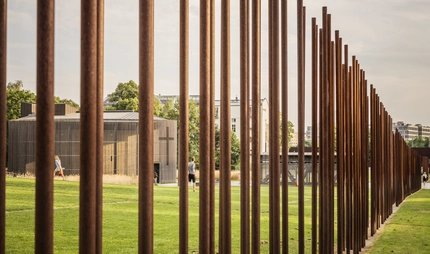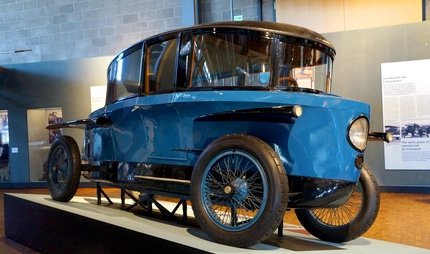
Gropius Bau
contemporary art at the Gropius Bau
Contemporary art behind a Renaissance facade: experience temporary exhibitions of international significance at the Gropius Bau. Check out the elaborate mosaics on the floor; they reflect several epochs and branches of the arts and crafts movement.
Once the Kunstgewerbemuseum, today one of the most important exhibition spaces in Berlin, the Gropius Bau is situated on the border between Berlin-Mitte and Kreuzberg. The museum regularly holds art exhibitions. Renowned international artists exhibit here. The exterior facade of the Renaissance-style building contrasts with an interior that combines the grand with the minimalistic. The architecture of the entire building is a magnet for visitors.
A meeting place for the international art scene
In 1877, the construction of a Museum of Applied Arts begins in the German Imperial capital. Architect Martin Gropius and his colleague Heino Schmieden design a building in the Italian Neo-Renaissance style. Four years later, the building is finished, and the collection presented to Berliners. The building sustains major damage during World War II, but in the 1960s its fortunes take a turn for the better. The grandnephew of the founding director of the Bauhaus, Walter Gropius, is vehemently committed to restoring it from a near ruinous state. Gradually refurbished throughout the 1970s, it again serves as an exhibition space. Berliner Festspiele organises exhibitions and concerts on its three levels. Your visit begins where the Berlin Wall once stood. From here, you enter directly into this exceptionally grand historic building. The mosaics and terracotta figurines on the facade are immediately noticeable. The entrance is elegant and stylishly decorated in white, reflecting the contemporary cultural zeitgeist. Immediately afterwards, you come to the heart of the building, a glass-enclosed atrium where the current exhibition is on display. Check out the elaborate mosaics on the floor; they reflect several epochs and branches of the arts and crafts movement. This is the backdrop for objects and installations by contemporary artists such as Ai Weiwei. Other famous names include Frida Kahlo, Olafur Eliasson and David Bowie.
Temporary events sometimes take place in the Gropius Bau, for example JazzFest Berlin or the national competitions of the Berliner Festspiele.
BauBau: children play here
The ground floor of the Gropius Bau has become very lively: there are rooms for playing, running around, laughing and being loud. Artist Kerstin Brätsch has launched BauBau a pilot project of a special kind. With a variety of structures, wallpaper, objects and materials, she invites children to play for free in the exhibition centre. A fixed concept for this was deliberately dispensed with; the rooms are to be further developed by the children themselves and their activities.
What to expect at the Gropius Bau
- Regularly changing exhibitions on art, history, photography and archaeology
- Light-flooded atrium with a glass roof and magnificent arcades
- Lavish terracotta decorations and gold mosaics on the facade
- Modern exhibition rooms, a lecture and cinema hall
- Vestibule (entrance hall) with a glass dome
- Baubau, the new play area for children (Bau will remain closed in February 2025)
Nearby attractions
As an art lover, you can visit many more exhibitions near the Gropius Bau: the Daimler art collection is only a few steps away at Potsdamer Platz. Over 2,200 works by internationally known artists are exhibited here. The focus is on abstract paintings of the 20th century up to current contemporary art. At Anton-Wilhelm-Amo-Straße station - is the Czech Centre. In this gallery, you can see exhibits of German and Czech artists. In addition, the centre organises regular readings and concerts. Further north, directly on Unter den Linden Boulevard, is Forum Willy Brandt. Here, you will get an overview of the life of the former German Chancellor and Nobel Peace Prize winner. Learn about his role as Mayor of Berlin and his commitment to reconciliation with Eastern Europe. Reports of strange but true stories of agents during the Cold War await you at the German Spy Museum at Leipziger Platz. The museum reveals the secrets of quirky intelligence monitoring methods. Here, you can even try navigating your way through a series of lasers. After a 15 minute walk from the Gropius building, you stand before the German Museum of Technology at the Landwehr Canal. Directly in front of the entrance, you see the Raisin Bomber from the 1940s on the roof. The museum is dedicated to air and space travel, shipping and the development of the steam engine.
Your visit to the Gropius Bau: practical information
Potsdamer Platz is the main transport hub for the Gropius Bau: the S-Bahn lines S1, S2 and S25 stop here. Alternatively, use Anhalter Bahnhof railway station which is located only 300 metres south of the Gropius Bau. The U-Bahn line U2 also stops at Potsdamer Platz. Bus numbers M41 and M29 are within walking distance. The (paying) car park right next to the Gropius Bau is convenient for drivers. Another large car park is located at Potsdamer Platz.
Discounts and disabled access
Admission is free for children and teenagers up to 16 years. Guided tours for school classes and workshops are available by appointment. Severely disabled persons (more than 50% disability) also get discounted admission. The building has disabled-accessible entrances and a disabled-accessible lift to all exhibition floors. The Gropius Bau is closed on Tuesdays.
Opening hours
| Monday | |
|---|---|
| Wednesday | |
| Thursday | |
| Friday | |
| Saturday | |
| Sunday |



